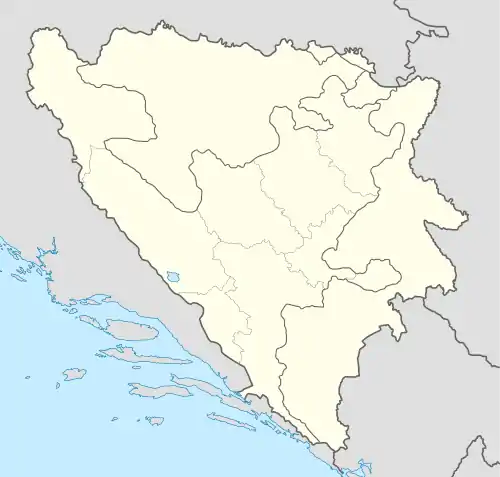Liplje
Липље | |
|---|---|
Village | |
 Liplje | |
| Coordinates: 44°21′52″N 19°04′23″E / 44.36444°N 19.07306°E | |
| Country | |
| Municipality | Zvornik |
| Time zone | UTC+1 (CET) |
| • Summer (DST) | UTC+2 (CEST) |
Liplje (Serbian Cyrillic: Липље) is a mountain village located in the municipality of Zvornik, Bosnia and Herzegovina, neighboring Snagovo. Within Liplje there are 14 settlements: Bajrići, Bećirovići, Čamlija, Hadžići, Husići, Jašići, Jošanica, Kadrići, Korin Brijeg, Liplje, Salihovići, Samari, Sultanovići and Velja Glava.
History
World War II
In July 1943, the Yugoslav Partisan-aligned 1st Proletarian Brigade, with Filip Kljajić serving as their political commissary,[1][2] liberated occupied Zvornik from the Wehrmacht and the troops of the occupying Independent State of Croatia. During withdrawal Kljajić died of an accidental gunshot on a hill on the outskirts of Zvornik.[3] His body was brought to Liplje and buried. Kljajić's body was taken in the 1960s from that spot by his family and reburied in a family plot elsewhere. A memorial was erected on the spot where his corpse was originally buried. Following the ethnic cleansing of Liplje in 1992 during the Bosnian War, the memorial suffered and became overgrown with shrubbery.
Bosnian War
Liplje concentration camp
At the start of the Bosnian War, armed Serb peasants from the nearby village of Snagovo overran Liplje on 1 May 1992 and, by 25 May, turned it into a concentration camp (see: Liplje camp) with the Bosniak (Muslim) residents becoming prisoners.[4] Between 420 and 460[5] people were imprisoned; men, women and children were beaten, raped repeatedly and killed by Serbs.[6] A total of 27 prisoners died. Escapees organized resistance groups in the towns of Cerska and Kamenica. On 1 June 1992,[7] about 300 Bosniaks armed with 27 rifles liberated the Liplje concentration camp.[8] It became the only camp with Bosniak prisoners to be liberated in the entirety of the 1992–95 war.[9][10] None of the Serb rapists from the camp have been brought to justice.[11]
Mass graves
In August 1998, a mass grave believed to be of victims killed in 1995, was discovered and exhumed, revealing at least 191 individuals, most of whom died of gunshot.[12][13] Several mass graves were found in Liplje, with exhumations still ongoing as of 2012.[14]
It was reported by Reuters on 8 July 2001 that a mass grave of approximately 200 victims of the 1995 Srebrenica Genocide was discovered in Liplje.[15]
Post-war
Bosniak returnees experience discrimination from the authorities of the Zvornik municipality, which fell into the hands of Republika Srpska after the war.[16]
The elementary school in Liplje, which taught around 400 children before the war, currently has only 20 students.[17] Liplje is one of the stops during the annual Marš mira (March of Peace).[18]
Flooding
Heavy rainfall in June 2010 set off several landslides and rock slides in Liplje. Due to the blockage of the flow of water, a local creek overflowed and swept away the main access road to the village. The flood also destroyed the crops of the Bosniak returnees.[19] More flooding and landslides were reported following heavy rainfall in March 2015.[20]
See also
References
- ↑ Šuber, Daniel; Karamanic, Slobodan (5 January 1942). Retracing Images: Visual Culture After Yugoslavia; page 327. ISBN 9789004210301. Retrieved 2 April 2015.
- ↑ "Dokumenti centralnih organa KPJ NOR i revolucija (1941-1945): (16. septembar-31. decembar 1941); page 471". 1985. Retrieved 2 April 2015.
- ↑ "Kako smo učili od Prve proleterske". E Novine. 18 November 2013. Retrieved 2 April 2015.
- ↑ "SVJEDOČENJE ŽRTVE ZLOČINA SILOVANJA" (PDF). ZZI. Archived from the original (PDF) on 13 May 2015. Retrieved 2 April 2015.
- ↑ "Godišnjica oslobođenja logora Liplje 1. juna u Zvorniku". Vijesti. 29 May 2012. Archived from the original on 2 April 2015. Retrieved 2 April 2015.
- ↑ Tuathail, Gearóid; Toal, Gerard; Dahlman, Carl T. (16 February 2011). Bosnia Remade: Ethnic Cleansing and Its Reversal; page 116. ISBN 978-0-19-973036-0. Retrieved 2 April 2015.
- ↑ "Dan kada je oslobođen prvi logor za Bošnjake u selima zvorničkog zaleđa". Kalesija. 1 June 2013. Retrieved 2 April 2015.
- ↑ Becirevic, Edina (1 July 2014). Genocide on the Drina River; pages 91 & 92. ISBN 9780300206807. Retrieved 2 April 2015.
- ↑ "Godišnjica oslobađanja koncentracionog logora Liplje". Radio Sarajevo. 2 June 2011. Archived from the original on 2 April 2015. Retrieved 2 April 2015.
- ↑ "Obilježavanje 22.godišnjice zločina nad bošnjacima: Zvornik sjećanje na logor u Liplju". Radio Glas Drine. 30 May 2014. Retrieved 2 April 2015.
- ↑ "Nijednom silovatelju iz Liplja nije suđeno". Dnevni avaz. 25 November 2008. Retrieved 10 April 2015.
- ↑ Klip, André (2005). The International Criminal Tribunal for the Former Yugoslavia 2001. ISBN 9789050953757. Retrieved 2 April 2015.
- ↑ Jennings, Christian (26 November 2013). Bosnia's Million Bones: Solving the World's Greatest Forensic Puzzle; page 69. ISBN 9781137278685. Retrieved 2 April 2015.
- ↑ "Ekshumacije na području Zvornika i Bratunca". Oslobođenje. 28 August 2012. Archived from the original on 2 April 2015. Retrieved 2 April 2015.
- ↑ "MASS GRAVE FOUND OF SREBRENICA VICTIMS". RFERL. 9 July 2001. Retrieved 2 April 2015.
- ↑ "Zvornik: 19 djece do škole prevoze u kamionu sa 5 mjesta". Nezavisne. 29 February 2012. Retrieved 15 April 2015.
- ↑ "PODRINJE "Avaz" u posjeti bošnjačkim selima u okolini Zvornika: Da se vlast za nas borila, danas bi nas manje bilo u azilu u Francuskoj i drugdje". Dnevni avaz. 9 November 2014. Retrieved 15 April 2015.
- ↑ "Mirsad i Omer preživjeli su marš smrti 1995. godine: Pješačimo za 30 ubijenih Malića". Oslobođenje. 9 July 2014. Archived from the original on 24 September 2015. Retrieved 15 April 2015.
- ↑ "Zvornik: Zbog klizišta i poplava odsječeno šest povratničkih sela". RTVTK. 22 June 2010. Retrieved 15 April 2015.
- ↑ "Zvornik: Ugroženi objekti i putevi". Glas Srpske. 16 March 2015. Retrieved 15 April 2015.